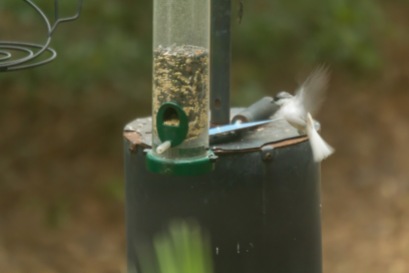SIB would like to introduce a new feature called “Ask SIB.” Please email us your bird related questions along with any photos. One of our experts, including our resident ornithologist Carl Helms, will research the question and provide an answer. We will also publish on our blog to educate all our members! Below is our first “Ask SIB.”
Dear SIB,
We have had this bird at our feeder and wondering if it is a mutant or some other kind of chickadee. The white on his tail and breast and back is really white, it is not just blown out. He is a very fast flyer and gets chased by the other birds but comes to the feeder a lot. I don’t think we have seen him the last day or two but was there pre storm and during the storm. Not great pictures but I wanted you to see the white. What do you think?
Patricia Schaefer
Hi Patricia
Thanks for your question and photos. I suspect this is a leucistic Carolina Chickadee. They can be nearly all white to patches of white. It is the same type of situation as our piebald deer, but different from Albinism. Below is a more detailed description of bird color variation from the Project Feederwatch website.
Thanks for sending your question!
Nancy
ALBINISM AND LEUCISM

Albinism is a genetic mutation that prevents the production of melanin (but not other pigments). Some colors come from pigments other than melanin, such as carotenoids. Albinism only applies to an absence of melanin; consequently, it is possible for a bird to be albinistic and still have color, although most consider true albinism to be an absence of all pigment.
Leucism is a genetic mutation that prevents melanin and other pigments from being deposited normally on feathers, resulting in pale or muted colors on the entire bird.
Albinistic birds have pink eyes because without melanin in the body, the only color in the eyes comes from the blood vessels behind the eyes. It is possible for a bird to be completely white and still have melanin in the body, as when a white bird has dark eyes. In this case the bird would be considered leucistic because the mutation only applies to depositing melanin in the feathers, not the absence of melanin in the body.


Source: Project Feederwatch – Color Variants (https://feederwatch.org/learn/unusual-birds/)






Ed and I have observed at least 2 leucistic chickadees at the feeders at Mingo Point at Kiawah in the last year and photographed them. I am wondering if they have found their way to your feeders. I will ask the naturalists if they are still hanging around there. Aija Konrad
LikeLike